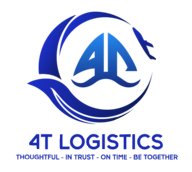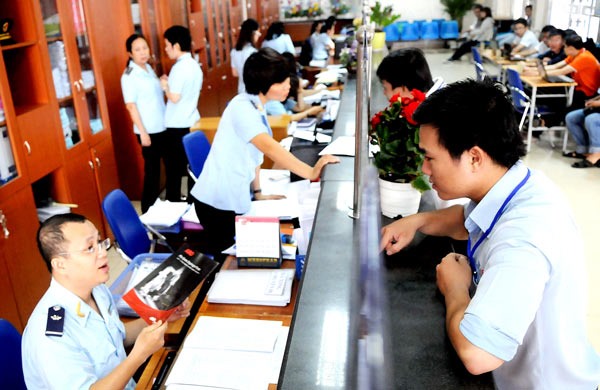Customs clearance is one of the most important steps in the import-export process.
Understanding the role of customs declaration activities and goods clearance procedures, 4T Logistics has continuously improved and become more and more perfect. Thanks to that, 4T Logistics is always committed to meeting the maximum needs of businesses, contributing significantly to the success of shipments.
4T Logistics' customs clearance service for the following activities:
+ Import and export business
+ Import and export processing
+ Import and export production and export
+ On-site import and export
+ Temporary export for re-import, temporary import for re-export
+ Import and export to raise capital, with tax and tax exemption
1. Carry out customs procedures for
Below are the steps to take when clearing customs for goods for import. However, there will be some differences in the process of working with specific types of goods and products.

To accurately grasp the details of the work that needs to be done, you can research carefully in advance, contact the customs office or seek advice from 4T Logistics.
1.1. Preparation: Gather the following documents for customs declaration:
+ Import permit (if goods require a permit for import)
+ Sales invoice
+ List of things to bring
+ Bill of lading is a document that describes the contents of a shipment.
+ Certificate of origin of goods C/O
+ Phytosanitary (fumigation certificate) and Fumigation (quarantine certificate) - if any
+ COA certificate of analysis
+ CQ quality certificate in English (If any)
1.2. Steps
Step 1: Declare import information (IDA):
Customs declarants declare import information using IDA operations before registering the import declaration.
Once all criteria have been declared on the IDA screen (133 criteria), the customs declarant sends it to the VNACCS system, the system will automatically issue a number, automatically output criteria related to tax rates, names, etc. corresponding to the entered codes (for example: the name of the importing country corresponds to the country code, the name of the importing unit corresponds to the business code...), automatically calculates criteria related to value and tax. …
After that, the system will respond to the customs declarant at the declaration registration screen - IDC.
When the system issues a number, the IDA import information declaration is saved on the VNACCS system.
Step 2: Register import declaration (IDC):
When receiving the declaration registration screen (IDC) responded by the system, the customs declarant checks the declared information and information automatically exported and calculated by the system. If you confirm that the information is correct, send it to the system to register the declaration.
In case after inspection, the customs declarant discovers that the declared information is incorrect and needs to be amended, he or she must use the IDB service to call back the import information declaration (IDA) screen to correct the information. necessary and perform the work as instructed above.
Step 3: Check the conditions for registering the declaration:
Before allowing declaration registration, the system will automatically check the List of businesses that are not eligible to register declarations (enterprises with overdue debts exceeding 90 days, enterprises that temporarily suspend operations, dissolve, or go bankrupt). product...).
If the enterprise belongs to the above list, it will not be allowed to register the declaration and the system will respond to the customs declarant. If eligible, businesses proceed to the next steps.
Step 4: Streaming, inspection, customs clearance: Once the declaration has been registered, the system automatically allocates channels, including 3 green, yellow, and red channels.
For declarations under the green channel:
In case the tax amount payable is 0:
The system automatically grants customs clearance (within an estimated time of 03 seconds) and issues to the declarant "Decision to clear imported goods".
In case the tax amount payable is different from 0:
In case you have declared and paid tax using a limit or made a guarantee (general or separate): The system automatically checks the declaration criteria related to the limit and guarantee.
+ If the limit or guarantee amount is greater than or equal to the tax amount payable, the system will issue to the declarant "a document recording the tax amount receivable" and "Decision on customs clearance of imported goods".
If the limit or guarantee amount is less than the tax payable, the system will report an error.
+ In case of immediate tax declaration (transfer, cash payment at the customs office...): The system outputs to the declarant "Voucher recording tax receivable".
When the customs declarant has paid taxes, fees, and charges and the VNACCS system has received information about the payment of taxes, fees, and charges, the system issues "Decision to clear goods".
At the end of the day, the VNACCS system gathers all cleared green channel declarations and transfers them to the VCIS system.
For yellow and red flow declarations
The system transfers online yellow and red stream declaration data from VNACCS to Vcis
For declarations in the yellow and red channels, after the customs authority carries out operations including checking and processing the declaration on the screen of the VCIS system, using CKO or CEA operations to complete/ instructions, the customs declarant needs to continue with the following steps:
+ Receive system feedback on results of channeling, location, form, and level of physical inspection of goods;
+ Submit paper documents to the customs authority to check the details of the documents; prepare conditions for physical inspection of goods;
+ Fulfill all obligations regarding taxes, fees, and charges (if any).
Step 5: Declare, amend and supplement during customs clearance
The system allows for declaration of amendments and supplements during customs clearance from after registering the declaration until before customs clearance of goods.
To make additional declarations during customs clearance, the customs declarant uses the IDD service to call up the screen to declare additional information and display all import declaration information (IDA). In case of declaration of amendments and supplements for the first time, or display the most updated amended import declaration information (IDA01) in case of declaration of amendments and supplements from the 2nd time onwards.






